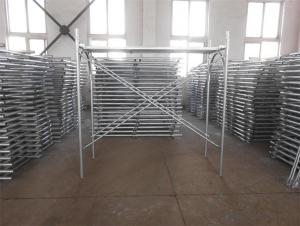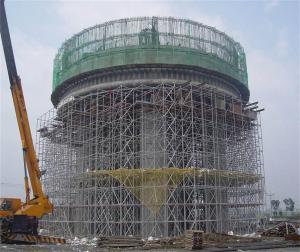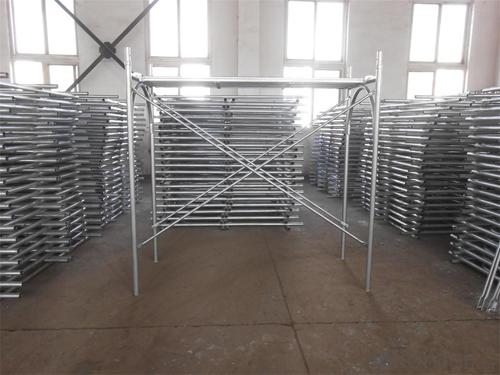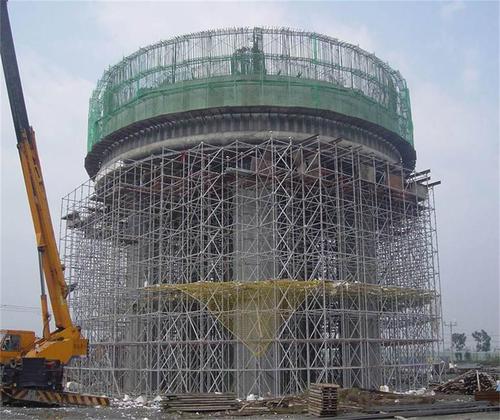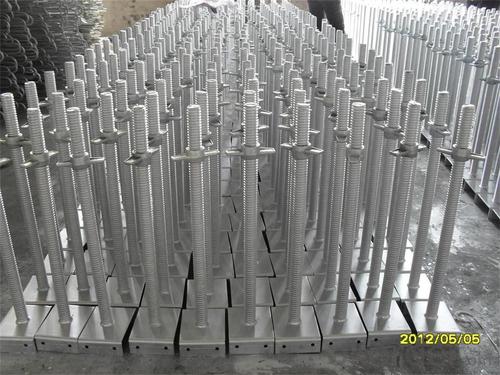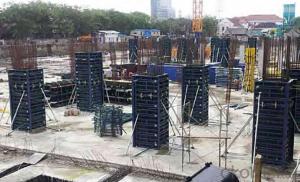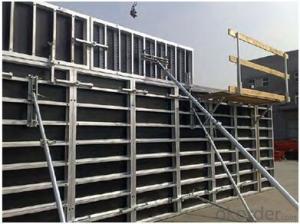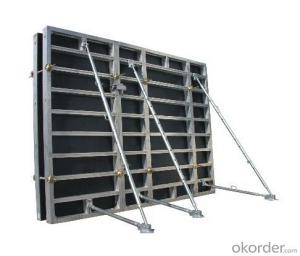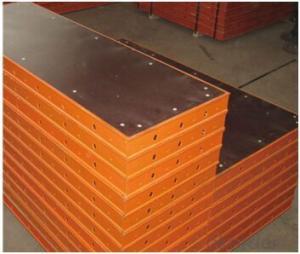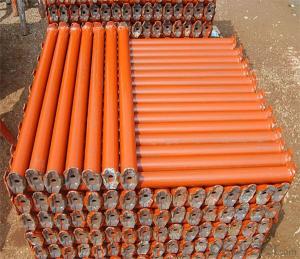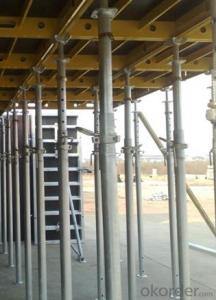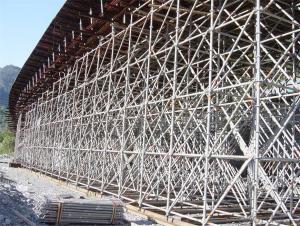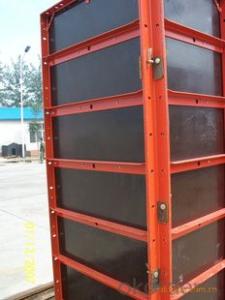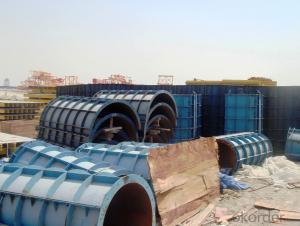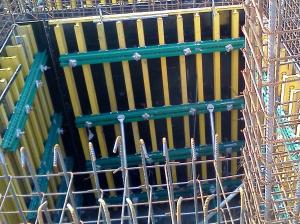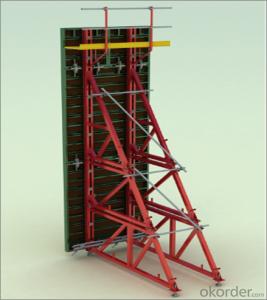Door Scaffolding , Ring lock, Tower Scaffolding with Hot or Cold Galvanized Surface
- Loading Port:
- Shanghai
- Payment Terms:
- TT OR LC
- Min Order Qty:
- 1000 m²
- Supply Capability:
- 100000 m²/month
OKorder Service Pledge
OKorder Financial Service
You Might Also Like
1.Structure of Ring lock Description
Ringlock Scaffolding system is the most popular used Scaffolding system in the world.It will greatly reduce the cost because of the following advantages
Packaging & Delivery
Packaging Details:
Pallet or bag or upon client's request
Delivery Detail:
35days
2.Main Features of Ringlock
It will greatly reduce the cost because of the following advantages
1)Using less pipes
2)Easy to install
3)It can be used again and again for nearly 20years
3.Ring lock product pictures:
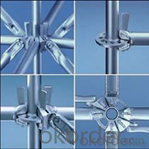
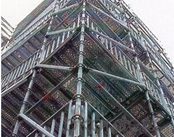
4.Ringlock Product Description
Type: ringlock scaffolding diagonal Brace
specification : Ø48.3×3.20
material:: steel Q235
Finished: Hot DIP galvanized, painted
Diagonal length(m) :Weight(kg)
0.9m * 1.25m 6.28
1.25m * 2.7m 11.45
5.FAQ
We have organized several common questions for our clients,may help you sincerely:
1)How about your company?
CNBM International Corporation, China National Building Materials (Group) Corporation, is one of the largest companies in China building material equipment industry, Our formwork and scaffolding are largely used in both domestic and all over world;
2)How many Scaffolding your company have?
Here comes our 5 types of Scaffolding systems:
- Cup lock Scaffolding(C-Lock Scaffolding)
- Ring lock Scaffolding
-Kwistage Scaffolding
-H-frame Scaffolding
-ID15 Scaffolding Tower, this type Scaffolding is the most widely used in construction, such like bridge.
3)How long can we receive the product after purchase?
Lead time is about 30days after getting the signed PI and deposit.
- Q: What are the common maintenance and repair procedures for steel frame formwork systems?
- Common maintenance and repair procedures for steel frame formwork systems typically involve regular inspections and maintenance tasks to ensure the durability and functionality of the system. Here are some common procedures: 1. Regular Cleaning: It is important to clean the steel frame formwork system after each use to remove any concrete residues, dirt, or debris. This can be done by using water, brushes, or pressure washers. Regular cleaning helps prevent the build-up of corrosive substances and ensures that the formwork remains in good condition. 2. Rust Removal: Steel frames are susceptible to rust, especially if exposed to moisture or corrosive materials. Regularly inspect the formwork for any signs of rust or corrosion. If rust is detected, it should be removed using appropriate rust removal techniques, such as sanding, wire brushing, or chemical rust removers. Once the rust is removed, the affected areas should be treated with anti-rust coatings to prevent future corrosion. 3. Alignment and Straightening: Over time, steel frame formwork systems may become misaligned or bent due to heavy loads or improper handling. Regularly check the alignment of the frames and ensure that they are straight and level. If any misalignment or bending is observed, the frames should be realigned or straightened using appropriate tools and techniques. This is essential to maintain the accuracy and stability of the formwork system. 4. Welding Repairs: If any cracks or damages are found in the steel frames, welding repairs may be necessary. Welding should be done by trained professionals using the appropriate welding techniques and equipment. This helps ensure the structural integrity of the formwork system and prevents further damage. 5. Lubrication: Some steel frame formwork systems have moving parts, such as hinges or adjustable components. Regularly lubricating these parts with suitable lubricants helps prevent friction and ensures smooth operation. Lubrication also helps protect the system from rust and corrosion. 6. Inspection of Accessories: In addition to the steel frames, it is important to inspect and maintain the accessories and components of the formwork system, such as nuts, bolts, pins, and clamps. These should be regularly checked for any signs of wear, damage, or corrosion. If any issues are detected, the damaged or worn-out accessories should be replaced promptly. 7. Storage and Handling: Proper storage and handling of the steel frame formwork system is crucial for its longevity. The formwork should be stored in a dry and well-ventilated area to prevent moisture accumulation. Avoid stacking the frames excessively, as this can lead to deformation or damage. When handling the formwork, use appropriate lifting equipment and techniques to prevent accidents and minimize stress on the frames. By following these common maintenance and repair procedures, steel frame formwork systems can be kept in optimal condition, ensuring their longevity and reliability in construction projects.
- Q: How does steel frame formwork handle the placement of external cladding and façade materials within the concrete structure?
- Steel frame formwork provides a strong and stable framework for the placement of external cladding and façade materials within the concrete structure. The steel frame acts as a support system, allowing for precise and accurate installation of cladding materials. It ensures that the cladding is securely attached to the concrete structure, offering durability and resistance to external forces such as wind and weather conditions. Additionally, the steel frame formwork facilitates efficient and streamlined construction processes, enabling the timely completion of the project.
- Q: How does steel frame formwork handle concrete curing in humid conditions?
- Steel frame formwork is an excellent choice for handling concrete curing in humid conditions due to its inherent properties. Firstly, steel is highly resistant to moisture, which means it can withstand the humid environment without getting damaged or deteriorating. This makes it a reliable option for formwork, as it will remain structurally stable throughout the curing process. Furthermore, steel frame formwork provides a solid and stable support system for the concrete during curing. This ensures that the concrete maintains its shape and integrity, even in high humidity. The steel frame offers strength and rigidity, preventing any deformation or sagging of the formwork. In humid conditions, the risk of mold or mildew growth is increased. However, steel formwork does not provide a suitable environment for these organisms to thrive. Its non-porous surface and resistance to moisture make it less prone to mold or mildew growth, ensuring a hygienic and safe curing process. Additionally, steel formwork allows for better air circulation and ventilation, which is crucial during concrete curing. The open design of the formwork allows moisture to evaporate more efficiently, aiding the curing process and reducing the risk of surface defects such as cracking or uneven drying. This is especially important in humid conditions where the evaporation rate may be slower. Overall, steel frame formwork is a suitable choice for concrete curing in humid conditions. It resists moisture, provides stability, prevents mold growth, and allows for proper ventilation, ensuring a successful and durable concrete curing process.
- Q: Can steel frame formwork be used for decorative concrete finishes?
- Indeed, decorative concrete finishes can be achieved through the utilization of steel frame formwork. This adaptable and long-lasting system can be tailored to produce an array of shapes, textures, and patterns on the concrete's surface. The steel frame offers steadfastness and reinforcement for the formwork, guaranteeing the precise and accurate formation of the desired design. Moreover, the steel frame formwork can be effortlessly modified and rearranged to accommodate various decorative components, including patterns, imprints, or textures. Consequently, it is an ideal option for attaining decorative finishes in concrete construction endeavors.
- Q: Can steel frame formwork be used for high-rise construction projects?
- High-rise construction projects can utilize steel frame formwork. This type of formwork offers a strong and durable option for constructing tall buildings. Its high load-bearing capacity is essential for providing the necessary support during the pouring and curing of concrete. Steel formwork systems are specifically designed to withstand the pressure exerted by the weight of concrete and other construction materials. The steel frames are constructed to be rigid and stable, ensuring that the formwork maintains its shape and position even when subjected to heavy loads. This is particularly important for high-rise buildings, where the formwork must withstand the vertical pressure created by the height of the structure. Furthermore, steel formwork systems can be easily adjusted and assembled to fit various shapes and sizes of high-rise buildings. The modular nature of steel formwork allows for flexibility in design and construction, making it suitable for complex architectural layouts and designs. In addition, steel formwork is known for its reusability. Once a high-rise construction project is finished, the steel frames can be disassembled, cleaned, and reused for future projects. This not only saves costs but also reduces construction waste and promotes sustainable construction practices. In conclusion, steel frame formwork is a suitable choice for high-rise construction projects due to its high load-bearing capacity, rigidity, adaptability, and reusability. It provides a robust and efficient solution for constructing tall buildings while meeting the unique requirements of such projects.
- Q: Can steel frame formwork be used for both residential and industrial construction projects?
- Yes, steel frame formwork can be used for both residential and industrial construction projects. Steel frame formwork is known for its versatility and durability, making it suitable for various types of construction projects. It provides a strong and stable support system for concrete structures, ensuring that the desired shape and dimensions are achieved during the pouring and curing process. Whether it is a residential building or an industrial facility, steel frame formwork can be adapted to meet the specific requirements and complexities of the project. Additionally, steel frame formwork allows for efficient and fast construction, reducing overall project timelines and costs. Thus, it is a reliable and widely used solution for both residential and industrial construction projects.
- Q: How does steel frame formwork compare to traditional timber formwork in terms of durability?
- Steel frame formwork is generally more durable than traditional timber formwork. Steel is a strong and robust material that can withstand heavy loads and extreme weather conditions, making it highly resistant to warping, cracking, and decay. In contrast, timber formwork is more prone to wear and tear, such as rotting, splitting, and deformation over time. Therefore, steel frame formwork offers a longer lifespan and requires less maintenance, making it a more durable option for construction projects.
- Q: How long does it take to set up steel frame formwork?
- The time it takes to set up steel frame formwork can vary depending on various factors such as the size and complexity of the project, the experience and expertise of the construction team, and the availability of necessary equipment. Generally, it can take anywhere from a few hours to a few days to set up steel frame formwork for a typical construction project.
- Q: Can steel frame formwork be used in projects with high architectural finish requirements?
- Projects with high architectural finish requirements can indeed make use of steel frame formwork. The utilization of steel frame formwork guarantees a remarkable level of accuracy and stability, thereby ensuring a uniform and precise architectural finish. This is of utmost importance in achieving a smooth and flawless end result. The steel frames can be easily adjusted and tailored to fit various shapes, curves, and angles, thereby accommodating intricate and complex architectural designs. Furthermore, steel frame formwork exhibits exceptional durability and is able to withstand the immense pressure exerted by the concrete during the pouring process. This ensures that the formwork remains intact and maintains its shape throughout the construction process. In conclusion, steel frame formwork is a dependable and adaptable choice that can fulfill the high architectural finish requirements of diverse construction projects.
- Q: The main beam is the beam that is connected to both ends of the beam In the main frame, the cross beam of the vertical and horizontal cross, why should it be connected at the intersection?Do you need a connection plate for welding? Directly to the steel repair, plug welding can not?
- Screw connection for steel structure Riveting, welding can be
Send your message to us
Door Scaffolding , Ring lock, Tower Scaffolding with Hot or Cold Galvanized Surface
- Loading Port:
- Shanghai
- Payment Terms:
- TT OR LC
- Min Order Qty:
- 1000 m²
- Supply Capability:
- 100000 m²/month
OKorder Service Pledge
OKorder Financial Service
Similar products
Hot products
Hot Searches
